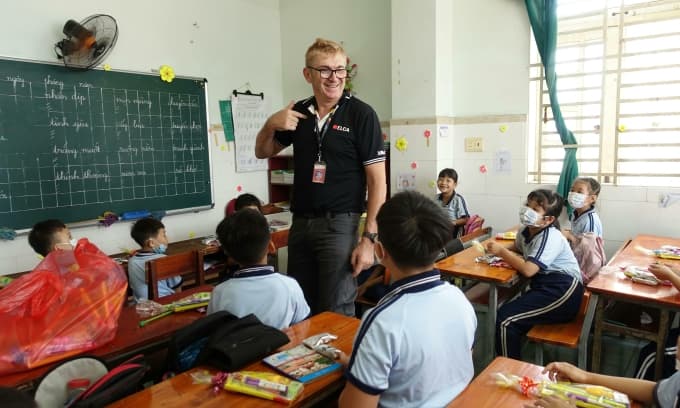A classroom goes silent
Across Vietnam, a familiar scene plays out when a foreign English teacher walks into a public school classroom. Students who have spent years studying grammar and vocabulary suddenly fall quiet. The teacher speaks at a natural speed, their sentences flow, and the class struggles to keep up. Eyes dart, notebooks stay blank, and students avoid being called on. Many have studied English for 7 to 10 years. Yet the moment feels like their first day with the language.
This is less a reflection of student ability than a mirror held up to the system. English is often taught as a school subject instead of a practical skill. The priority is exam scores, not conversation. In many classes, students hear slow and careful English from local teachers and practice written exercises designed to prepare for tests. Their ears do not get daily exposure to rhythm, stress, blending of sounds, or the pace of real conversations. The result is predictable. When real world English arrives, students freeze.
The pattern is not new. English became compulsory in middle and high schools in the 1980s and spread to primary schools in the 1990s. Interest boomed after Vietnam joined the World Trade Organization in 2006 and has stayed high. Millions of students now spend hundreds of hours learning English. Yet outcomes have lagged behind expectations. On the national high school graduation exam, English remains one of the weakest subjects for a large share of students, year after year. International comparisons also place Vietnam in a lower proficiency band. The gap between effort and results is clear, and families can see it when a native speaker enters the room and the class goes silent.
Why years of study still fall short
Time on task is not the core problem. Students in primary schools often attend four English periods per week, and those in secondary and high school take three per week. By the 2022 to 2023 school year, more than 2.9 million students had studied English for at least a decade under official programs. B1 proficiency on the Common European Framework of Reference for Languages (CEFR) typically requires around 350 to 400 guided learning hours. Vietnamese students often exceed that time in school and through extra classes. Yet many still struggle to understand everyday speech.
Several factors push toward this result. Large classes limit speaking time for each student. Exam oriented curricula encourage memorization, not interaction. Listening tasks in textbooks are often scripted and slow, which does not prepare ears for the natural speed of real conversations. Students fear making mistakes in front of peers. Many local teachers carry heavy workloads and have limited time for speaking activities. In rural areas, access to qualified teachers and authentic audio resources is uneven. These pressures add up.
Policy has aimed to change this picture. Since the launch of major language education initiatives in the past decade, Vietnam has invested in teacher development and curriculum reform. The National Foreign Language Project 2020 (NFLP 2020) sought to improve proficiency across the system. Results fell short of ambitious targets. Researchers point to predictable constraints: large classes, uneven materials, limited classroom time, and shortages of teachers trained in communicative methodology. English is often treated as a subject added on top of dense school schedules, not as a skill woven through daily learning.
Families try to fill the gap. English centers have multiplied in big cities, and private tutoring is common. Fees can be high relative to household income, and quality varies. This private market expands access to foreign teachers and authentic listening input for some. It does not reach every child.
Inside the public school classroom
What happens inside the typical public school English lesson helps explain why students freeze with a foreign teacher. Many classes have about 45 students, sometimes more. Students are grouped by age, not by ability. One class may include a student who speaks comfortably and another who is learning basic phonics. A single lesson must fit all. With this dynamic, teachers often rely on choral repetition, short drills, and board work to control the room. Speaking turns are limited. Real conversation is rare.
Support in class varies. Some teachers work with a teaching assistant who helps manage groups and translate instructions. In other classes, support is inconsistent or absent. Technology ranges from fully equipped rooms to chalk and a speaker that barely carries to the back row. Hot, crowded spaces make concentration harder. Teachers travel between multiple campuses, facing traffic and last minute changes to schedules. They carry backup activities in case a projector fails. Most manage all this with resilience and creativity, but the environment restricts how much natural interaction they can create for every student.
Teachers who supplement local curricula often focus on pronunciation, game based practice, and listening to authentic speech. These activities provide valuable exposure. Yet the short time slot, the mixed ability range, and the pressure to align with exam content still limit progress. Students get a taste of real English, then return to a system that rewards correct answers on paper more than messy attempts at conversation.
The policy push to make English universal
Vietnam plans to make English a compulsory second language in all schools by 2035. English would become mandatory from Grade 1 by 2030, with exposure beginning in pre school. Officials link this goal to global competitiveness and to the needs of a modern workforce. By the middle of the century, English is expected to be widely used across tens of thousands of public schools serving tens of millions of students. The vision is bold. It signals a national commitment to language skills as part of human capital.
Implementation will be the test. Estimates suggest the system could face a shortage of more than twenty thousand English teachers by 2030. Many teachers also need support to shift from test focused practice to communicative teaching. In rural and remote areas, recruiting and retaining qualified staff is hard. Requirements for foreign teachers have tightened, which can make hiring more difficult beyond major cities. Parents will likely continue to pay for private classes if school provision does not meet expectations, which risks widening gaps by income and location.
A seasoned reform leader has framed the challenge bluntly. Bui Manh Hung, former chief coordinator of Vietnam’s general education reform, has long warned about capacity constraints and classroom practice.












